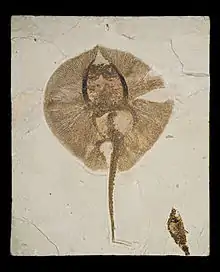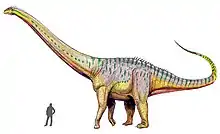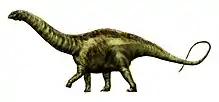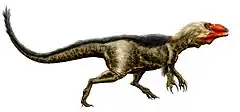| |||
|---|---|---|---|
|
Paleontology or palaeontology is the study of prehistoric life forms on Earth through the examination of plant and animal fossils.[1] This includes the study of body fossils, tracks (ichnites), burrows, cast-off parts, fossilised feces (coprolites), palynomorphs and chemical residues. Because humans have encountered fossils for millennia, paleontology has a long history both before and after becoming formalized as a science. This article records significant discoveries and events related to paleontology that occurred or were published in the year 1877.
Arthropods
Newly named insects
| Name | Novelty | Status | Authors | Age | Type locality | Country | Notes | Images |
|---|---|---|---|---|---|---|---|---|
|
Anthomyia burgessi[2] |
Sp nov |
Quesnel |
An anthomyiid fly. |
 Anthomyia burgessi (1890 illustration) | ||||
|
Anthomyia inanimata[2] |
Sp nov |
Quesnel |
An anthomyiid fly. |
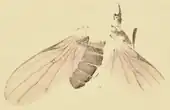 Anthomyia inanimata (1890 illustration) | ||||
|
Sp nov |
Quesnel |
A myrmicine ant, possibly nomen dubium.[5] |
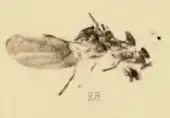 Aphaenogaster longaeva (1890 illustration) | |||||
|
Boletina sepulta[2] |
Sp nov |
valid |
Quesnel |
A fungus gnat. |
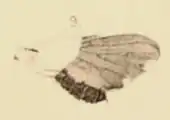 Boletina sepulta (1890 illustration) | |||
|
Brachypeza abita[2] |
Sp nov |
valid |
Quesnel |
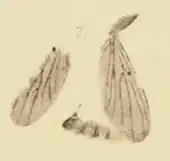 Brachypeza abita (1890 illustration) | ||||
|
Brachypeza procera[2] |
Sp nov |
valid |
Quesnel |
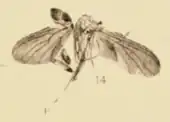 Brachypeza procera (1890 illustration) | ||||
|
Calyptites[2] |
Gen et sp nov |
valid |
Quesnel |
An ant of uncertain placement. |
 Calyptites antediluvianum (1890 illustration) | |||
|
Formica arcana[2] |
Sp nov |
valid |
Quesnel |
A formicine ant |
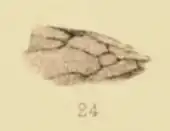 Formica arcana (1890 illustration) | |||
|
Hypoclinea obliterata[2] |
Sp nov |
jr synonym |
Quesnel |
A dolichoderine ant |
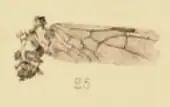 Dolichoderus obliteratus (1890 illustration) | |||
|
Heteromyza senilis[2] |
Sp nov |
valid |
Quesnel |
 Heteromyza senilis (1890 illustration) | ||||
|
Lachnus petrorum[2] |
Sp nov |
jr synonym |
Quesnel |
An aphidomorph of uncertain placement |
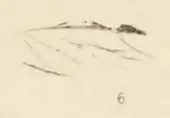 Geranchon petrorum (1890 illustration) | |||
|
Liometopum pingue[4] |
Sp nov |
valid |
An ant species, moved to Eoformica pingue in 1930 |
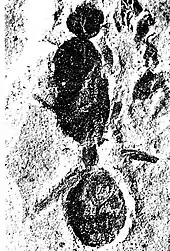 Eoformica pinguis | ||||
|
Lithortalis[2] |
Gen et sp nov |
valid |
Quesnel |
A picture-winged fly. |
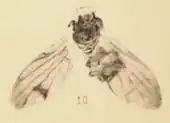 Lithortalis picta (1890 illustration) | |||
|
Lonchaea senescens[2] |
Sp nov |
valid |
Quesnel |
A lauxaniid fly. |
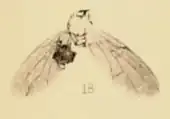 "Lonchaea" senescens (1890 illustration) | |||
|
Palloptera morticina[2] |
Sp nov |
valid |
Quesnel |
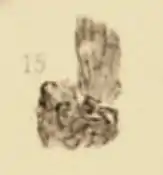 Palloptera morticina (1890 illustration) | ||||
|
Pimpla decessa[2] |
Sp nov |
valid |
Quesnel |
A pimpline ichneumon parasitic wasp |
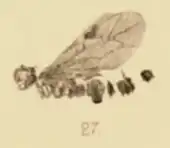 Pimpla decessa (1890 illustration) | |||
|
Pimpla saxea[2] |
Sp nov |
valid |
Quesnel |
A pimpline ichneumon parasitic wasp |
 Pimpla saxea (1890 illustration) | |||
|
Pimpla senecta[2] |
Sp nov |
valid |
Quesnel |
A pimpline ichneumon parasitic wasp |
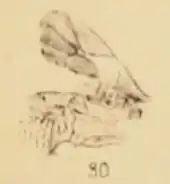 Pimpla senecta (1890 illustration) | |||
|
Prometopia depilis[2] |
Sp nov |
valid |
Quesnel |
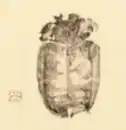 Prometopia depilis (1890 illustration) | ||||
|
Sciomyza revelata[2] |
Sp nov |
valid |
Quesnel |
A marsh fly. |
 Sciomyza revelata (1890 illustration) | |||
|
Trichonta dawsoni[2] |
Sp nov |
valid |
Quesnel |
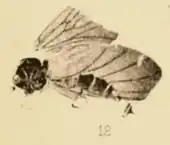 Trichonta dawsoni (1890 illustration) | ||||
Fish
| Name | Novelty | Status | Authors | Age | Unit | Location | Notes | Images |
|---|---|---|---|---|---|---|---|---|
|
gen et sp nov. |
Valid |
One of two stingrays from the Green River Formation |
| |||||
Non-dinosaurian reptiles
| Name | Novelty | Status | Authors | Age | Unit | Location | Notes | Images |
|---|---|---|---|---|---|---|---|---|
|
Junior synonym |
Late Triassic |
A misidentified ornithosuchid archosaur whose name was preoccupied by MacLeay, 1819. It was later renamed Dasygnathoides. Synonym of Ornithosuchus | ||||||
|
Late Triassic |
Dubious genus of misidentified phytosaur. | |||||||
|
Dubious genus of misidentified phytosaur. | ||||||||
Dinosaurs
Laelaps trihedrodon, Cope criticizes Dryptosaurus
O. W. Lucas collected the first remains of what would later in the year be named Laelaps trihedrodon from Quarry I of the Saurian Hill at Garden Park, Colorado.[10] Edward Drinker Cope would describe the material later in the year in a short paper titled "On a carnivorous dinosaurian from the Dakota beds of Colorado."[11] The "Dakota beds" he references are actually Morrison Formation strata.[10] Cope claims to have a skeleton of unspecified completeness on which to establish the new species, but only describes a partial dentary which has 5 successional teeth, 2 functional teeth, and one tooth missing from its socket.[11] All of the preceding material has since been lost to science with the exception of 5 broken, partial tooth crowns.[12] From the now missing dentary, Cope infers that the creature is a carnivore and compares its dentition to that belonging to other members of his infamous genus "Laelaps", L. aquilunguis and L. incrassatus.[11] Cope concludes the paper with a pointed criticism of his rival O. C. Marsh's attempt to rename Laelaps as the genus Dryptosaurus because the generic name Laelaps has been used in entomology.[13] Cope claims that since the mite genus Laelaps was a synonym that the name was not truly preoccupied and Marsh's erection of Dryptosaurus has therefore created a new, redundant synonym of Laelaps the dinosaur.[13] However, subsequent researchers have supported Marsh's new name.
Apatosaurus
- Apatosaurus specimen found with preserved gastroliths.[14]
New genera
|
||||||||||||||||||||||||||||||||||||||||||||||||||||||||||||||||||||||||||||||||||||||||||||||||||||||||||||||||||||||||||
Synapsids
Non-mammalian
| Name | Status | Authors | Age | Location | Notes | Images |
|---|---|---|---|---|---|---|
|
Synonym of Clepsydrops |
||||||
See also
Footnotes
- ↑ Gini-Newman, Garfield; Graham, Elizabeth (2001). Echoes from the past: world history to the 16th century. Toronto: McGraw-Hill Ryerson Ltd. ISBN 9780070887398. OCLC 46769716.
- 1 2 3 4 5 6 7 8 9 10 11 12 13 14 15 16 17 18 19 20 Scudder, S. H (1877). "Appendix to Mr. George M. Dawson's report. The insects of the Tertiary beds at Quesnel". Geological Survey of Canada, Report of Progress for. 1875–1876: 266–280.
- 1 2 Michelsen, V. (1996). "First reliable record of a fossil species of Anthomyiidae (Diptera), with comments on the definition of recent and fossil clades in phylogenetic classification". Biological Journal of the Linnean Society. 58 (4): 441–451.
- 1 2 Carpenter, F. M. (1930). "The fossil ants of North America" (PDF). Bulletin of the Museum of Comparative Zoology. 70: 1–66.
- ↑ Radchenko, A. G.; Perkovsky, E. E. (2016). "The ant Aphaenogaster dlusskyana sp. nov. (Hymenoptera, Formicidae) from the Sakhalin amber—the earliest described species of an extant genus of Myrmicinae". Paleontological Journal. 50 (9): 936–946. doi:10.1134/S0031030116090136.
- ↑ Dalla Torre, K. W. (1893). Catalogus Hymenopterorum hucusque descriptorum systematicus et synonymicus. Vol. 7. Formicidae (Heterogyna). Leipzig: W. Engelmann. p. 289.
- ↑ Scudder, S. H. (1890). "The Tertiary insects of North America". United States Geological Survey of the Territories, Washington: 615.
- ↑ Evenhuis (1994). Catalogue of the Fossil Flies of the World (Insecta: Diptera). Backhuys Publishers. pp. 1–600.
- ↑ Grande, Lance (1984), "Paleontology of the Green River Formation, with a review of the fish fauna", Bulletin of the Wyoming State Geological Survey, Laramie, WY, 63 2nd ed.
- 1 2 "Introduction," Chure (2001) page 11.
- 1 2 3 Cope (1887) pages 805-806.
- ↑ "Description of 5780," Chure (2001) page 11.
- 1 2 Cope (1887) page 806.
- ↑ Cannon (1907). Sanders, Manley, and Carpenter (2001), "Table 12.1" page 167.
References
- Cannon, G.L. (1907). Sauropodan gastroliths. Science 24, 116.
- Chure, Daniel J. (2001). "On the type and referred material of Laelaps trihedrodon Cope 1877 (Dinosauria: Theropoda)". In Tanke, Darren; Carpenter, Kenneth (eds.). Mesozoic Vertebrate Life. Bloomington and Indianapolis: Indiana University Press. pp. 10–18. ISBN 0-253-33907-3.
- Cope, E.D. (1877). On a carnivorous dinosaurian from the Dakota beds of Colorado. Bull. U.S. Geol. Surv. Territories 3: 805–806.
- Sanders F, Manley K, Carpenter K. Gastroliths from the Lower Cretaceous sauropod Cedarosaurus weiskopfae. In: Tanke D.H, Carpenter K, editors. Mesozoic vertebrate life: new research inspired by the paleontology of Philip J. Currie. Indiana University Press; Bloomington, IN: 2001. pp. 166–180.
